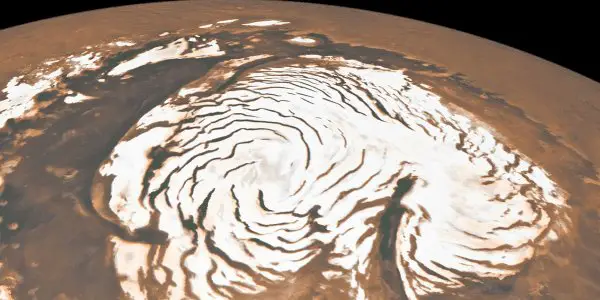Scientists Just Found Water On Mars — Where They Thought It Couldn’t Exist
Tags: News

By Amanda Froelich Truth Theory
Though it is a well-established fact that Mars had large bodies of water over a million years ago, only traces of the ancient Martian lakes have been found in recent years. Organizations such as NASA used probes and landers to conclude where water is likely — and not likely — to be. Now, astronomers from the Applied Physics Laboratory (APL) of Johns Hopkins University have found large deposits of water in what may be permafrost ice. Most importantly, they are exactly where scientists did not think water would ever be.
Futurism reports that the ice was discovered in an area called the Medusae Fossae, which is a patch of permafrost several hundred kilometers across. Because it’s on the Martian equator, scientists figured the location would be too warm for ice to stay intact near the surface.
In 2008, it was confirmed that Mars has permafrost ice at its polar regions. This data was provided by the Odyssey spacecraft’s neutron spectrometer. Reportedly, The specialized spectrometer picks up on neutron radiation being emitted from the red planet when high-energy cosmic rays rain down from space. Johns Hopkins’ APL planetary astronomer Jack Wilson told Cosmos: “These interact with the top meter of the soil and kick out particles, neutrons included.”
By analyzing the particles, scientists can identify what substances the cosmic rays interacted with — and continue to do so. When Wilson and his team gave the data a second review, they realized that earlier studies had a very low resolution at around 520 kilometers. After improving the resolution to 290 kilometers, they discovered high concentrations of water — about 40 percent of the region by weight. “[It’s] similar to lowering the altitude of the spacecraft by 50%,” Wilson said. “You’re getting a better view of what’s going on.” The team’s findings were published in the journal Icarus.
This finding leads scientists to believe that water on Mars is more prevalent than once thought. In an APL press release, Wilson said: “Perhaps the signature could be explained in terms of extensive deposits of hydrated salts, but how these hydrated salts came to be in the formation is also difficult to explain. So for now, the signature remains a mystery worthy of further study, and Mars continues to surprise us.”
Read more: Scientists Discover That Mars Could Contain A Lot More Water Than Previously Believed
IMAGE CREDIT:NASA/JPL-CALTECH/MSSS
THIS ARTICLE IS OFFERED UNDER CREATIVE COMMONS LICENSE. IT’S OKAY TO REPUBLISH IT ANYWHERE AS LONG AS ATTRIBUTION BIO IS INCLUDED AND ALL LINKS REMAIN INTACT.
I am Luke Miller, content manager at Truth Theory and creator of Potential For Change. I like to blend psychology and spirituality to help you create more happiness in your life.Grab a copy of my free 33 Page Illustrated eBook- Psychology Meets Spirituality- Secrets To A Supercharged Life You Control Here

Leave Comment: